MENU
The Electronic Scholarly Publishing Project: Providing access to classic scientific papers and other scholarly materials, since 1993. More About: ESP | OUR CONTENT | THIS WEBSITE | WHAT'S NEW | WHAT'S HOT
Comparative Timelines
The ESP Timeline (one of the site's most popular features) has been completely updated to allow the user to select (using the timeline controls above each column) different topics for the left and right sides of the display.
Select:
New Left Column
New Left Column
Dates
Decade
New Right Column
New Right Column
(no entry for this year)
1950
(no entry for this year)
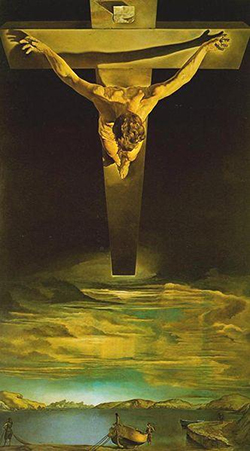 Painting by Salvador Dalí: Christ of Saint John of the Cross depicts Jesus Christ on the cross in a darkened sky floating over a body of water complete with a boat and fishermen. Although it is a depiction of the crucifixion, it is devoid of nails, blood, and a crown of thorns, because, according to Dalí, he was convinced by a dream that these features would mar his depiction of Christ. Also in a dream, the importance of depicting Christ in the extreme angle evident in the painting was revealed to him.
Painting by Salvador Dalí: Christ of Saint John of the Cross depicts Jesus Christ on the cross in a darkened sky floating over a body of water complete with a boat and fishermen. Although it is a depiction of the crucifixion, it is devoid of nails, blood, and a crown of thorns, because, according to Dalí, he was convinced by a dream that these features would mar his depiction of Christ. Also in a dream, the importance of depicting Christ in the extreme angle evident in the painting was revealed to him.
1951
(no entry for this year)
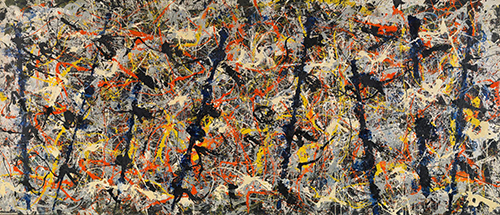 Painting by Jackson Pollock: Number 11, 1952, also known as Blue Poles, is one of the most famous works by American artist Jackson Pollock. It was purchased amid controversy by the National Gallery of Australia in 1973 and today remains one of the gallery's major paintings. At the time of the painting's creation, Pollock preferred not to assign names to his works, but rather numbers; hence, the original title of the painting was simply "Number 11"' or "No. 11" for the year 1952. In 1954, the new title Blue Poles was first seen at an exhibition at the Sidney Janis Gallery and reportedly originated from Pollock himself. According to art historian Dennis Phillips, the specific rather than ambiguous title "limits our field of comprehension and does the painting a singular disservice. Because we look for the poles and miss much of the rest, the name is simply too distracting."
Painting by Jackson Pollock: Number 11, 1952, also known as Blue Poles, is one of the most famous works by American artist Jackson Pollock. It was purchased amid controversy by the National Gallery of Australia in 1973 and today remains one of the gallery's major paintings. At the time of the painting's creation, Pollock preferred not to assign names to his works, but rather numbers; hence, the original title of the painting was simply "Number 11"' or "No. 11" for the year 1952. In 1954, the new title Blue Poles was first seen at an exhibition at the Sidney Janis Gallery and reportedly originated from Pollock himself. According to art historian Dennis Phillips, the specific rather than ambiguous title "limits our field of comprehension and does the painting a singular disservice. Because we look for the poles and miss much of the rest, the name is simply too distracting."
1952
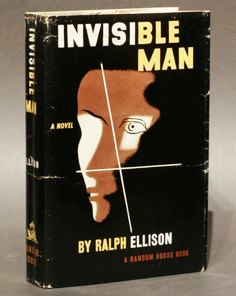 Ralph Ellison publishes Invisible Man.
Ralph Ellison publishes Invisible Man.
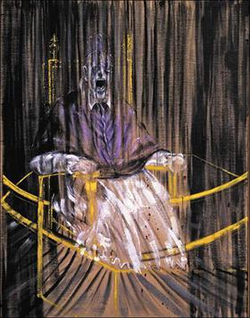 Painting by Francis Bacon: Study after Velázquez's Portrait of Pope Innocent X shows a distorted version of the Portrait of Innocent X painted by Spanish artist Diego Velázquez in 1650. The work is one of a series of over 45 variants of the Velázquez painting which Bacon executed throughout the 1950s and early 1960s. The picture was described by Gilles Deleuze as an example of creative re-interpretation of the classical. When asked why he was compelled to revisit the subject so often, Bacon replied that he had nothing against the Popes, that he merely sought "an excuse to use these colours, and you can't give ordinary clothes that purple colour without getting into a sort of false fauve manner".
Painting by Francis Bacon: Study after Velázquez's Portrait of Pope Innocent X shows a distorted version of the Portrait of Innocent X painted by Spanish artist Diego Velázquez in 1650. The work is one of a series of over 45 variants of the Velázquez painting which Bacon executed throughout the 1950s and early 1960s. The picture was described by Gilles Deleuze as an example of creative re-interpretation of the classical. When asked why he was compelled to revisit the subject so often, Bacon replied that he had nothing against the Popes, that he merely sought "an excuse to use these colours, and you can't give ordinary clothes that purple colour without getting into a sort of false fauve manner".
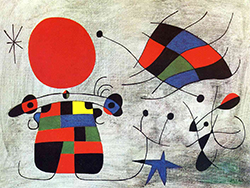 Painting by Joan Miró: The Smile of the Flamboyant Wings — the first in a series of similarly impulsive paintings. Some even feature Miro's handprints — a pleading gesture for which he derived his inspiration from pre-historic cave drawings. The use of materials and gestures became increasingly important factors in Miro's works. For a while he devoted himself exclusively to ceramics and developed some new techniques together with Artigas. It was with great energy that Miro subsequently took up painting again in 1960. With his new large-format paintings he picked up the thread of his series of pictures of 1953/54, while at the same time developing them further in the direction of poetic sensitivity.
Painting by Joan Miró: The Smile of the Flamboyant Wings — the first in a series of similarly impulsive paintings. Some even feature Miro's handprints — a pleading gesture for which he derived his inspiration from pre-historic cave drawings. The use of materials and gestures became increasingly important factors in Miro's works. For a while he devoted himself exclusively to ceramics and developed some new techniques together with Artigas. It was with great energy that Miro subsequently took up painting again in 1960. With his new large-format paintings he picked up the thread of his series of pictures of 1953/54, while at the same time developing them further in the direction of poetic sensitivity.
1953
(no entry for this year)
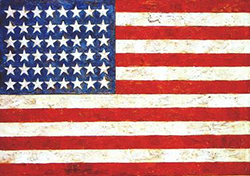 Painting by Jasper Johns: Flag is an encaustic painting created when Johns was 24 (1954-55), two years after he was discharged from the US Army. This painting was the first of many works that Johns has said were inspired by a dream of the U.S. flag in 1954. It is arguably the painting for which Johns is best known. The US flag was in the news repeatedly in 1954. The McCarthy hearings came to a close on 17 June 1954, only three days after Flag Day. On Flag Day, U.S. President Dwight D. Eisenhower signed an amendment to the pledge of allegiance to add the words "under God." The New York Times ran article on facts and myths associated with the flag on the day before Flag Day, and then an article on the "discipline" of the flag on Flag Day itself, saying, with reference to a national air-raid drill "we are all soldiers now". Francis Scott Key, composer of "The Star Spangled Banner", was born in 1779, 175 years before 1954. The Iwo Jima Marine Memorial at Arlington National Cemetery, with its large US flag, was dedicated on 11 November 1954. Johns and his father were both named after Sergeant William Jasper, who saved the fallen flag of the Americans at Fort Moultrie in the American Revolutionary War. The work measures 42.2 inches by 60.6 inches. It is made using encaustic, oil paint, and newsprint collage on three separate canvases, mounted on a plywood board. The painting reflects the three colors of the US flag: red, white and blue; the flag is depicted in the form it took between 1912 and 1959, with 48 white stars on a blue canton representing the then-US states (excluding Alaska and Hawaii), and with thirteen red and white stripes. Newsprint is visible under the stripes. Reading the texts, it is clear that the newsprint was not selected at random: Johns steered clear of headlines, or national or political news, and used inconsequential articles or adverts. The painting has a rough-textured surface, and the 48 stars are not identical. It is dated 1954 on its reverse.
Painting by Jasper Johns: Flag is an encaustic painting created when Johns was 24 (1954-55), two years after he was discharged from the US Army. This painting was the first of many works that Johns has said were inspired by a dream of the U.S. flag in 1954. It is arguably the painting for which Johns is best known. The US flag was in the news repeatedly in 1954. The McCarthy hearings came to a close on 17 June 1954, only three days after Flag Day. On Flag Day, U.S. President Dwight D. Eisenhower signed an amendment to the pledge of allegiance to add the words "under God." The New York Times ran article on facts and myths associated with the flag on the day before Flag Day, and then an article on the "discipline" of the flag on Flag Day itself, saying, with reference to a national air-raid drill "we are all soldiers now". Francis Scott Key, composer of "The Star Spangled Banner", was born in 1779, 175 years before 1954. The Iwo Jima Marine Memorial at Arlington National Cemetery, with its large US flag, was dedicated on 11 November 1954. Johns and his father were both named after Sergeant William Jasper, who saved the fallen flag of the Americans at Fort Moultrie in the American Revolutionary War. The work measures 42.2 inches by 60.6 inches. It is made using encaustic, oil paint, and newsprint collage on three separate canvases, mounted on a plywood board. The painting reflects the three colors of the US flag: red, white and blue; the flag is depicted in the form it took between 1912 and 1959, with 48 white stars on a blue canton representing the then-US states (excluding Alaska and Hawaii), and with thirteen red and white stripes. Newsprint is visible under the stripes. Reading the texts, it is clear that the newsprint was not selected at random: Johns steered clear of headlines, or national or political news, and used inconsequential articles or adverts. The painting has a rough-textured surface, and the 48 stars are not identical. It is dated 1954 on its reverse.
1954
(no entry for this year)
1955
(no entry for this year)
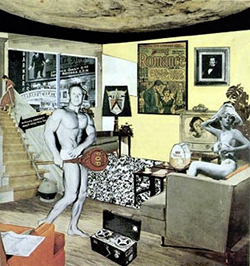 Collage by Richard Hamilton: Just what is it that makes today's homes so different, so appealing? measures 10.25 in (260 mm) × 9.75 in (248 mm). The work is now in the collection of the Kunsthalle Tübingen, Tübingen, Germany. It was the first work of pop art to achieve iconic status. Just what is it that makes today's homes so different, so appealing? was created in 1956 for the catalogue of the exhibition This Is Tomorrow in London, England in which it was reproduced in black and white. In addition, the piece was used in posters for the exhibit. Hamilton and his friends John McHale and John Voelcker had collaborated to create the room that became the best-known part of the exhibition.
Collage by Richard Hamilton: Just what is it that makes today's homes so different, so appealing? measures 10.25 in (260 mm) × 9.75 in (248 mm). The work is now in the collection of the Kunsthalle Tübingen, Tübingen, Germany. It was the first work of pop art to achieve iconic status. Just what is it that makes today's homes so different, so appealing? was created in 1956 for the catalogue of the exhibition This Is Tomorrow in London, England in which it was reproduced in black and white. In addition, the piece was used in posters for the exhibit. Hamilton and his friends John McHale and John Voelcker had collaborated to create the room that became the best-known part of the exhibition.
1956
(no entry for this year)
(no entry for this year)
1957
(no entry for this year)
(no entry for this year)
1958
(no entry for this year)
(no entry for this year)
1959
(no entry for this year)
ESP Quick Facts
ESP Origins
In the early 1990's, Robert Robbins was a faculty member at Johns Hopkins, where he directed the informatics core of GDB — the human gene-mapping database of the international human genome project. To share papers with colleagues around the world, he set up a small paper-sharing section on his personal web page. This small project evolved into The Electronic Scholarly Publishing Project.
ESP Support
In 1995, Robbins became the VP/IT of the Fred Hutchinson Cancer Research Center in Seattle, WA. Soon after arriving in Seattle, Robbins secured funding, through the ELSI component of the US Human Genome Project, to create the original ESP.ORG web site, with the formal goal of providing free, world-wide access to the literature of classical genetics.
ESP Rationale
Although the methods of molecular biology can seem almost magical to the uninitiated, the original techniques of classical genetics are readily appreciated by one and all: cross individuals that differ in some inherited trait, collect all of the progeny, score their attributes, and propose mechanisms to explain the patterns of inheritance observed.
ESP Goal
In reading the early works of classical genetics, one is drawn, almost inexorably, into ever more complex models, until molecular explanations begin to seem both necessary and natural. At that point, the tools for understanding genome research are at hand. Assisting readers reach this point was the original goal of The Electronic Scholarly Publishing Project.
ESP Usage
Usage of the site grew rapidly and has remained high. Faculty began to use the site for their assigned readings. Other on-line publishers, ranging from The New York Times to Nature referenced ESP materials in their own publications. Nobel laureates (e.g., Joshua Lederberg) regularly used the site and even wrote to suggest changes and improvements.
ESP Content
When the site began, no journals were making their early content available in digital format. As a result, ESP was obliged to digitize classic literature before it could be made available. For many important papers — such as Mendel's original paper or the first genetic map — ESP had to produce entirely new typeset versions of the works, if they were to be available in a high-quality format.
ESP Help
Early support from the DOE component of the Human Genome Project was critically important for getting the ESP project on a firm foundation. Since that funding ended (nearly 20 years ago), the project has been operated as a purely volunteer effort. Anyone wishing to assist in these efforts should send an email to Robbins.
ESP Plans
With the development of methods for adding typeset side notes to PDF files, the ESP project now plans to add annotated versions of some classical papers to its holdings. We also plan to add new reference and pedagogical material. We have already started providing regularly updated, comprehensive bibliographies to the ESP.ORG site.
ESP Picks from Around the Web (updated 06 MAR 2017 )
Old Science

Weird Science

Treating Disease with Fecal Transplantation
Fossils of miniature humans (hobbits) discovered in Indonesia

Dinosaur tail, complete with feathers, found preserved in amber.
Astronomy

Mysterious fast radio burst (FRB) detected in the distant universe.